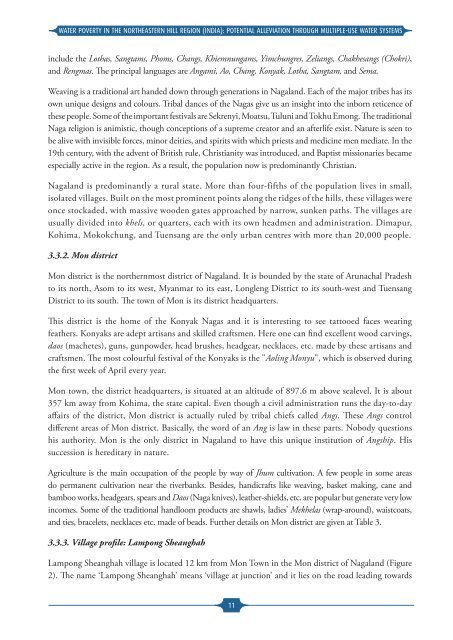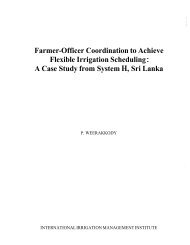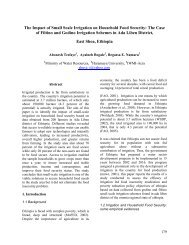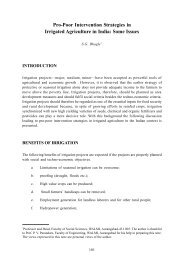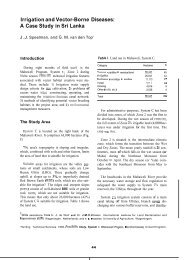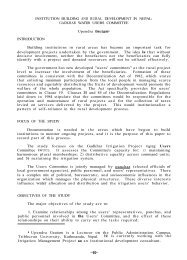WATER POVERTY IN THE NORTHEASTERN HILL REGION (INDIA)
WATER POVERTY IN THE NORTHEASTERN HILL REGION (INDIA)
WATER POVERTY IN THE NORTHEASTERN HILL REGION (INDIA)
Create successful ePaper yourself
Turn your PDF publications into a flip-book with our unique Google optimized e-Paper software.
<strong>WATER</strong> <strong>POVERTY</strong> <strong>IN</strong> <strong>THE</strong> NOR<strong>THE</strong>ASTERN <strong>HILL</strong> <strong>REGION</strong> (<strong>IN</strong>DIA): POTENTIAL ALLEVIATION THROUGH MULTIPLE-USE <strong>WATER</strong> SYSTEMSinclude the Lothas, Sangtams, Phoms, Changs, Khiemnungams, Yimchungres, Zeliangs, Chakhesangs (Chokri),and Rengmas. The principal languages are Angami, Ao, Chang, Konyak, Lotha, Sangtam, and Sema.Weaving is a traditional art handed down through generations in Nagaland. Each of the major tribes has itsown unique designs and colours. Tribal dances of the Nagas give us an insight into the inborn reticence ofthese people. Some of the important festivals are Sekrenyi, Moatsu, Tuluni and Tokhu Emong. The traditionalNaga religion is animistic, though conceptions of a supreme creator and an afterlife exist. Nature is seen tobe alive with invisible forces, minor deities, and spirits with which priests and medicine men mediate. In the19th century, with the advent of British rule, Christianity was introduced, and Baptist missionaries becameespecially active in the region. As a result, the population now is predominantly Christian.Nagaland is predominantly a rural state. More than four-fifths of the population lives in small,isolated villages. Built on the most prominent points along the ridges of the hills, these villages wereonce stockaded, with massive wooden gates approached by narrow, sunken paths. The villages areusually divided into khels, or quarters, each with its own headmen and administration. Dimapur,Kohima, Mokokchung, and Tuensang are the only urban centres with more than 20,000 people.3.3.2. Mon districtMon district is the northernmost district of Nagaland. It is bounded by the state of Arunachal Pradeshto its north, Asom to its west, Myanmar to its east, Longleng District to its south-west and TuensangDistrict to its south. The town of Mon is its district headquarters.This district is the home of the Konyak Nagas and it is interesting to see tattooed faces wearingfeathers. Konyaks are adept artisans and skilled craftsmen. Here one can find excellent wood carvings,daos (machetes), guns, gunpowder, head brushes, headgear, necklaces, etc. made by these artisans andcraftsmen. The most colourful festival of the Konyaks is the "Aoling Monyu", which is observed duringthe first week of April every year.Mon town, the district headquarters, is situated at an altitude of 897.6 m above sealevel. It is about357 km away from Kohima, the state capital. Even though a civil administration runs the day-to-dayaffairs of the district, Mon district is actually ruled by tribal chiefs called Angs. These Angs controldifferent areas of Mon district. Basically, the word of an Ang is law in these parts. Nobody questionshis authority. Mon is the only district in Nagaland to have this unique institution of Angship. Hissuccession is hereditary in nature.Agriculture is the main occupation of the people by way of Jhum cultivation. A few people in some areasdo permanent cultivation near the riverbanks. Besides, handicrafts like weaving, basket making, cane andbamboo works, headgears, spears and Daos (Naga knives), leather-shields, etc. are popular but generate very lowincomes. Some of the traditional handloom products are shawls, ladies’ Mekhelas (wrap-around), waistcoats,and ties, bracelets, necklaces etc. made of beads. Further details on Mon district are given at Table 3.3.3.3. Village profile: Lampong SheanghahLampong Sheanghah village is located 12 km from Mon Town in the Mon district of Nagaland (Figure2). The name ‘Lampong Sheanghah’ means ‘village at junction’ and it lies on the road leading towards11


